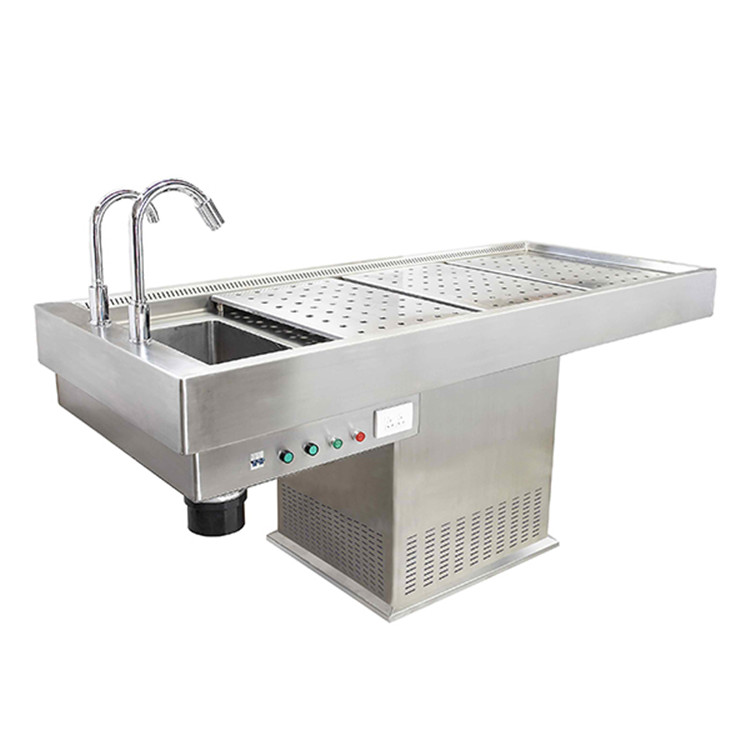
In modern mortuary and forensic environments, ensuring safety and maintaining sterility are non-negotiable priorities. One of the most critical pieces of mortuary equipment that supports these goals is the Autopsy Table. At ysenmed-morgue, we provide state-of-the-art solutions that enhance operational efficiency and safety standards in medical and forensic facilities. This article explores how autopsy tables contribute to safety and sterility, how to choose the right table, and what best practices to follow for long-term, secure usage.
An Autopsy Table is specifically designed for the examination and dissection of human cadavers. These tables, also referred to as post-mortem examination tables, forensic autopsy tables, or medical cadaver tables, are integral to operations in hospitals, mortuaries, and forensic labs. Their robust construction, often in stainless steel, supports hygienic and ergonomic cadaver handling.
Some models include advanced features like adjustable height, integrated drainage systems, and ventilation for odor and particle control. In these settings, cadaver handling systems must align with rigorous hygiene protocols and minimize exposure to biohazards.
Sterility is essential during post-mortem procedures. A high-quality Autopsy Table typically includes smooth, seamless surfaces for easy cleaning. Integrated with stainless steel examination tables, they help prevent bacterial buildup and are resistant to harsh cleaning agents.
Additionally, integrated water faucets, splash guards, and drainage systems contribute to effective contamination control, ensuring that bodily fluids and particles do not spread to surrounding areas. These features also facilitate safe disinfection after each use.
Autopsy procedures carry biological and chemical risks. Modern morgue autopsy tables are designed with ergonomic and safety features, such as side railings, foot-operated height controls, and non-slip surfaces. These help reduce physical strain on workers and prevent accidents.
Furthermore, when paired with forensic pathology tools, such as proper ventilation and suction systems, they contribute to a safer, cleaner working environment.
Efficiency in post-mortem analysis is just as important as safety. Autopsy tables equipped with built-in lighting, power outlets, and tool holders streamline the examination process. In conjunction with a body dissection workstation, these features improve access to instruments and help pathologists maintain focus on their procedures.
Digital integration is becoming increasingly relevant. Tables that can connect with imaging or documentation systems reduce manual data entry and enhance workflow automation.
Always select tables constructed with high-quality stainless steel examination table materials for durability and hygiene. The material must resist corrosion and be able to withstand repeated exposure to disinfectants and bodily fluids.
An essential part of any forensic autopsy table is its ventilation system. Tables that connect with lab exhaust systems or include built-in ventilation prevent unpleasant odors and aerosol dispersion. This feature is critical in supporting pathogen containment protocols.
Tables should allow height and tilt adjustments to reduce physical strain and improve access during procedures. Models with hydraulic lifts or electric controls offer enhanced precision and flexibility.
Built-in sinks, faucets, power outlets, and instrument trays can significantly improve usability. These features reduce the need for external equipment and support a more sterile and efficient setup.
Ensure the Autopsy Table meets local and international standards for medical equipment. CE certification or FDA approval indicates the table has passed safety and performance tests, essential for operational compliance.
Regular cleaning of the autopsy table with hospital-grade disinfectants is non-negotiable. Ensure all fluids are drained, surfaces are wiped down, and biohazardous materials are properly disposed of.
Personnel must be trained in both operation and emergency procedures. They should also understand how to correctly handle forensic pathology tools, and how to prepare and disinfect the medical cadaver table.
Proper use of personal protective equipment, including gloves, gowns, masks, and face shields, is critical. Safety barriers or sneeze guards can add extra protection during high-risk procedures.
Incorporate proper waste disposal methods into the workflow. Ensure that biological and chemical waste generated during autopsies is handled according to local regulations.
Inspect and service the table regularly to ensure all fixtures are working and that drainage and ventilation systems are clear. Preventative maintenance helps avoid breakdowns and contamination issues.
Fluid overflow or drainage blockage: Regular flushing of drainage systems and inspection of piping is essential.
Corrosion or surface damage: Only use recommended cleaning agents and inspect for wear regularly.
Ventilation failures: Pair with reliable mortuary equipment suppliers like ysenmed-morgue for technical support and parts.
Staff fatigue or strain: Choose ergonomic designs with adjustability for various user heights and body positions.
Today’s autopsy rooms are increasingly equipped with integrated systems. Many facilities now use video documentation tools for legal and educational purposes. In these setups, the post-mortem examination table becomes a central hub, connecting equipment and providing a workspace that meets diverse needs.
Moreover, the role of the autopsy table is expanding. In research and educational facilities, its functionality includes compatibility with imaging tools and tissue sample collection devices. These integrations align with the growing use of clinical pathology tools and digital pathology solutions.
As technology evolves, the Autopsy Table is expected to become smarter and more connected. Future advancements include:
IoT-Enabled Monitoring: Tables equipped with sensors to track temperature, fluid levels, and contamination status.
AI-Powered Analysis: Integration with image recognition software for enhanced documentation and training.
Eco-Friendly Materials: Use of sustainable construction materials that meet sterilization standards.
Automated Disinfection Systems: UV sterilizers or self-cleaning surfaces to reduce manual labor and risk.
These features are expected to raise safety standards and further align with sustainable healthcare practices.
The Autopsy Table is more than just a surface for examination—it's a key component of safe, sterile, and efficient post-mortem operations. By focusing on proper selection, routine maintenance, and staff training, mortuaries and forensic labs can significantly reduce contamination risks and improve operational workflows.
Whether you're equipping a new facility or upgrading your current workspace, choosing the right autopsy table can elevate your entire operation. At ysenmed-morgue, we offer a wide range of pathology dissection tables, morgue autopsy table, and cadaver handling systems tailored to meet diverse institutional needs.
Invest in safety, invest in performance. Visit ysenmed-morgue today to explore our full catalog of mortuary solutions and elevate your lab's standards.